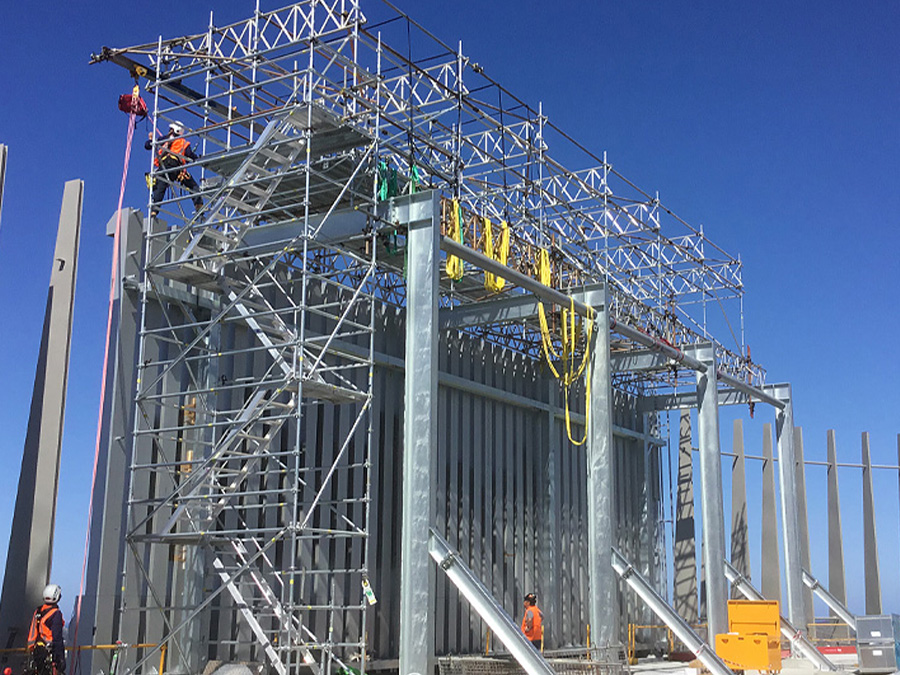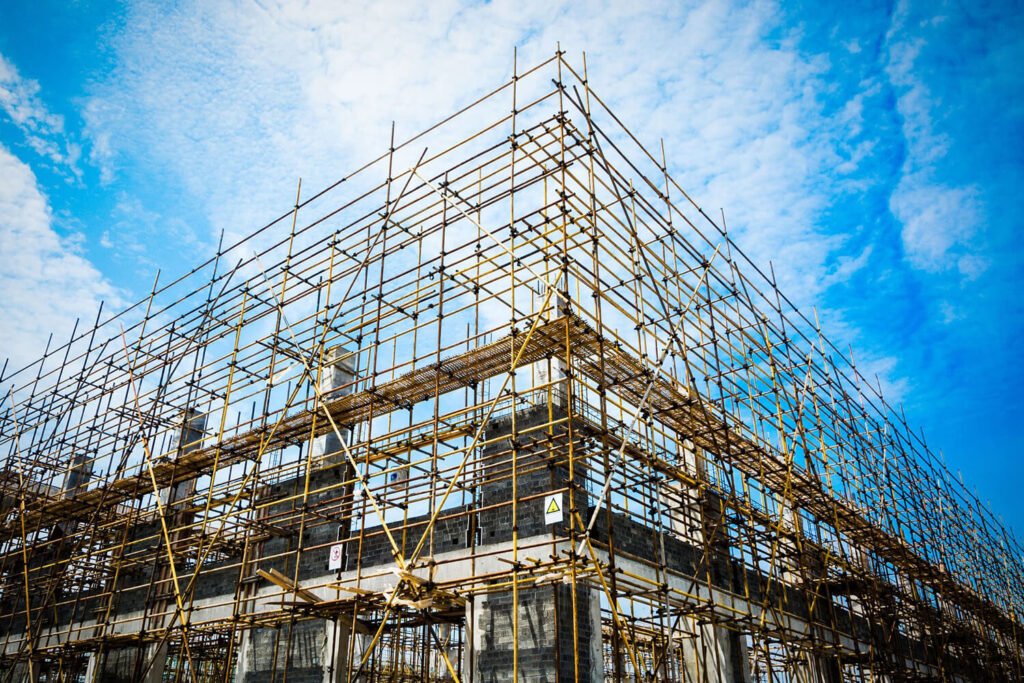Top-Notch Scaffolding Near Me: Expert Solutions for Every Job
Top-Notch Scaffolding Near Me: Expert Solutions for Every Job
Blog Article
A Comprehensive Overview to the Crucial Functions of Scaffolding in Modern Building
The landscape of modern-day building and construction significantly depends on efficient scaffolding systems that focus on efficiency, innovation, and safety. As jobs grow in intricacy, recognizing the crucial attributes of scaffolding ends up being vital for guaranteeing worker safety and maximizing job timelines.
Types of Scaffolding
Although scaffolding systems can differ extensively in style and application, they generally fall under several distinct groups that satisfy different building and construction requirements - Scaffolding. The most usual types consist of sustained scaffolding, suspended scaffolding, and rolling scaffolding
Sustained scaffolding includes systems supported by a framework of posts, which offer a elevated and secure functioning surface area. This type is commonly utilized for tasks that call for considerable altitude, such as bricklaying or outside painting.
Put on hold scaffolding, on the other hand, is made use of for jobs calling for accessibility to high elevations, such as cleaning or fixing structure exteriors. This system hangs from a roof or another structure, allowing workers to lower or elevate the system as needed.
Rolling scaffolding functions wheels that enable very easy mobility across a task site. It is specifically valuable for tasks that require frequent relocation, such as interior operate in huge rooms.
Each kind of scaffolding is designed with specific applications in mind, making certain that building jobs can be performed effectively and properly. Recognizing these categories is essential for choosing the suitable scaffolding system to meet both project requirements and site conditions.
Key Safety Features
Safety is paramount in scaffolding systems, as the potential threats related to operating at elevations can cause severe mishaps if not correctly managed. Key safety and security attributes are necessary to make sure the wellness of workers and the integrity of the building and construction website.
Primarily, guardrails are important. These barriers provide a physical guard versus falls, considerably reducing the threat of severe injuries. Additionally, toe boards are often made use of to stop devices and products from diminishing the scaffold, securing employees listed below.
Another crucial part is the use of non-slip surface areas on platforms. This attribute improves grip, specifically in negative weather, thus minimizing the probability of slips and drops. Accessibility ladders should be safely placed to help with secure entry and departure from the scaffold.
Regular assessments and upkeep of scaffolding systems are also essential. These evaluations make certain that all components are in excellent condition and working appropriately, addressing any type of wear or damages promptly.
Finally, appropriate training for all workers associated with scaffolding operations is vital to make certain that they understand security methods and can recognize potential risks. Scaffolding. Jointly, these attributes develop a safer working environment and substantially minimize risks associated with scaffolding
Material Advancements
Advancements in material science have significantly affected the scaffolding sector, improving both security and efficiency in modern building and construction. The intro of high-strength steel and light weight aluminum alloys has revolutionized traditional scaffolding systems.
In addition, ingenious composite materials, such as fiberglass-reinforced plastics, have actually arised as practical alternatives. These products are resistant to corrosion and ecological deterioration, thus expanding the life-span of scaffolding systems, particularly in harsh climate conditions. The use of such products adds to lower upkeep expenses and ensures regular efficiency over time.


Layout Considerations
Considering the complexities of modern-day building projects, reliable scaffolding style is critical to ensuring both capability and security. Design factors to consider should incorporate different elements, consisting of tons capacity, elevation, and Go Here the specific needs of the construction website. Each job presents special challenges, demanding a versatile approach to scaffolding systems that can adjust to varying conditions.
Structural integrity is essential; as a result, designers need to compute the tons that the scaffolding will certainly support, consisting of workers, materials, and tools. The choice of products plays an essential duty in guaranteeing the scaffolding can hold up against these loads while continuing to be lightweight and sturdy. Additionally, the style must permit very easy access and egress, promoting the smooth movement of materials and employees.
Safety functions, such as guardrails and non-slip surface areas, must be included to reduce dangers of crashes. The design needs to take into consideration the surrounding setting, consisting of possible hazards and adjacent structures. By addressing these design considerations, building firms can enhance the effectiveness of scaffolding systems and promote a safer working environment, ultimately adding to the total success of the task.
Upkeep and Examinations
The performance of scaffolding systems expands past preliminary style and application; ongoing maintenance and normal examinations are essential to guaranteeing their continued performance and safety throughout the duration of a task. Routine assessments ought to be conducted by qualified employees to recognize any kind of indications of wear, damage, or instability that could compromise the integrity of the scaffolding.
Upkeep protocols should consist of regular checks of architectural parts, such as installations, planks, and frames, guaranteeing that all aspects remain totally free and safe from rust or various other wear and tear. Additionally, the performance of safety attributes, such as guardrails and toe boards, should be investigate this site assessed to make sure compliance with security regulations.
Paperwork of all inspections and upkeep tasks is critical for responsibility and governing compliance. An organized approach to record-keeping not only help in tracking the condition of the scaffolding however additionally provides needed evidence in the occasion of an incident.
Inevitably, establishing an extensive upkeep and inspection routine will dramatically reduce the danger of crashes and enhance the overall security of the building and construction website. By focusing on these practices, building supervisors can guard workers and support the job's honesty.

Conclusion
In conclusion, the essential attributes of scaffolding in modern-day building encompass a variety of essential components, consisting of diverse types, vital safety and security systems, material innovations, scaffolding sales and thoughtful layout factors to consider. Emphasizing safety and security via guardrails and non-slip surfaces, alongside innovations in materials like high-strength steel, enhances both efficiency and sustainability. Routine upkeep and evaluations are essential for making sure architectural stability and safety and security on building and construction sites, inevitably helping with reliable project execution and advertising the well-being of employees.
The landscape of modern-day building significantly relies on efficient scaffolding systems that focus on safety, effectiveness, and innovation.Advancements in material scientific research have considerably affected the scaffolding sector, boosting both safety and effectiveness in contemporary building and construction. Overall, these material developments not only improve the efficiency and safety of scaffolding systems however likewise line up with the sector's press in the direction of sustainability, as several modern materials are developed to be much more eco pleasant.
Taking into consideration the complexities of modern construction projects, effective scaffolding design is critical to making sure both performance and security.In final thought, the necessary features of scaffolding in modern-day building and construction incorporate a variety of important aspects, including diverse types, vital safety and security devices, product advancements, and thoughtful design considerations.
Report this page